One of the most simple but essential ingredients that we use just about every single day in one form or another is the egg. Without it, there would be no soufflés, omelets, or even the egg in its most simple form: poached. A perfectly poached egg satisfies far beyond its simplicity.
You just might be shell-shocked (pun intended) by how amazing these sous vide poached eggs are
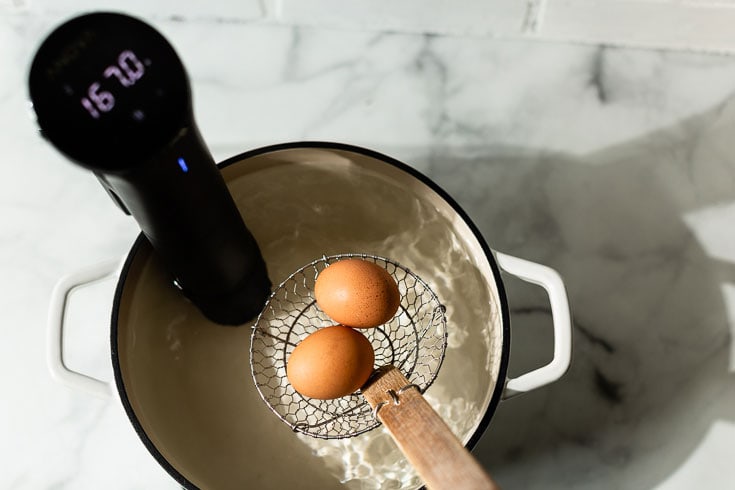
The texture is heavenly and difficult to achieve by the usual methods of poaching eggs. A texture that is rich, yet light as air. Almost impossible to describe, so you just have to give it a try.
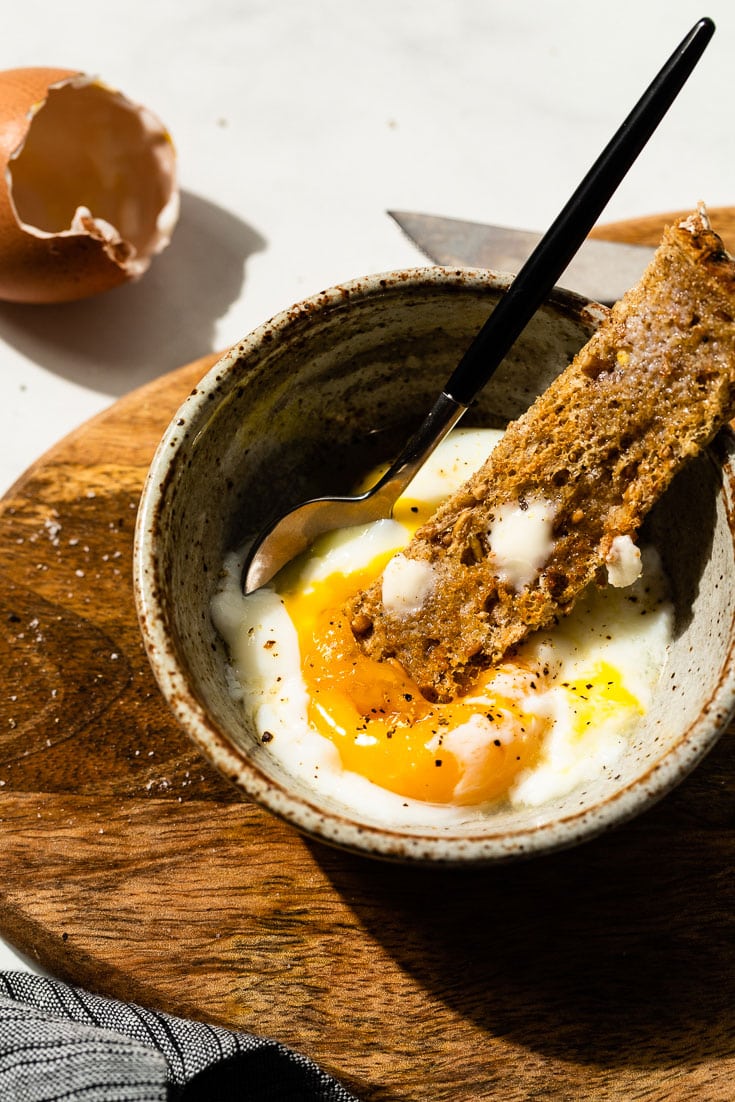
Why Sous Vide Eggs Anyway?
What’s the point of going non-traditional and pulling out the science? The answer is the amazing texture. The other huge benefit of poaching eggs sous vide is that poaching eggs the traditional method is hard, especially at scale. It’s often super messy, there can be a lot of lost eggs, and it requires paying close attention to every little egg.
None of that is the case when you sous vide eggs. Drop them (gently) right in the water, still in their shell, and wait for 13 minutes 30 seconds to perfection. Crack when ready, and enjoy.
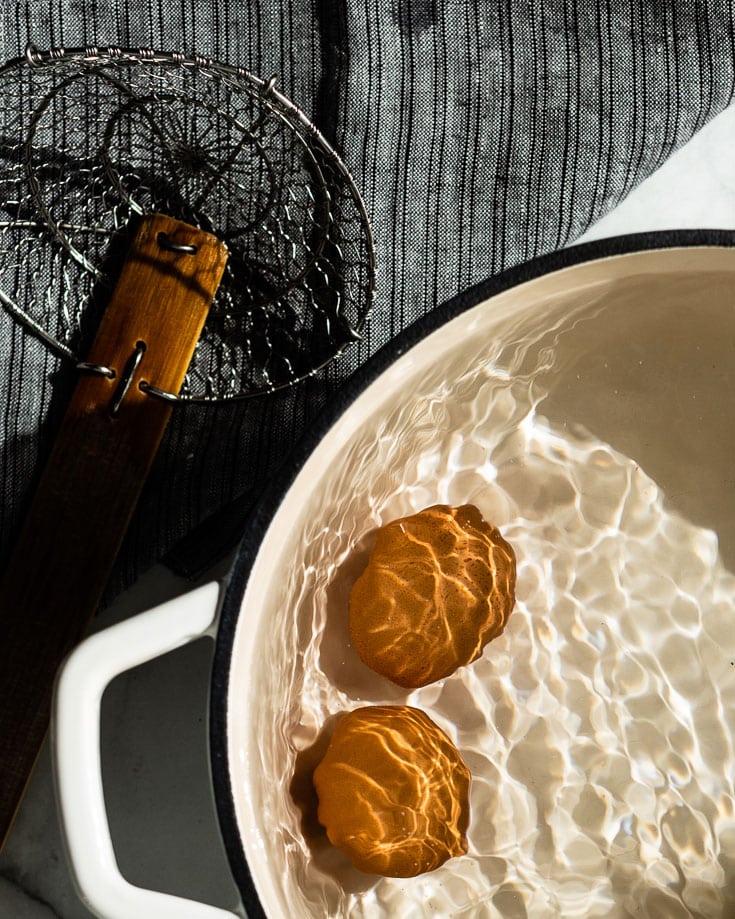
How to Make Poached Eggs Sous Vide
Grab your sous vide machine, water bath and however many eggs you want to cook. Set the temperature to 75° C / 167° F (for soft cooked). Eggs are just about the only ingredient I know that goes into the sous vide water bath without being vacuum sealed.
It’s tough to name these eggs. They are not technically soft-boiled (because they are cooked well below boiling temperature), they are sort of poached (but in their shell). Whatever you want to call them is just fine. I call them perfect.
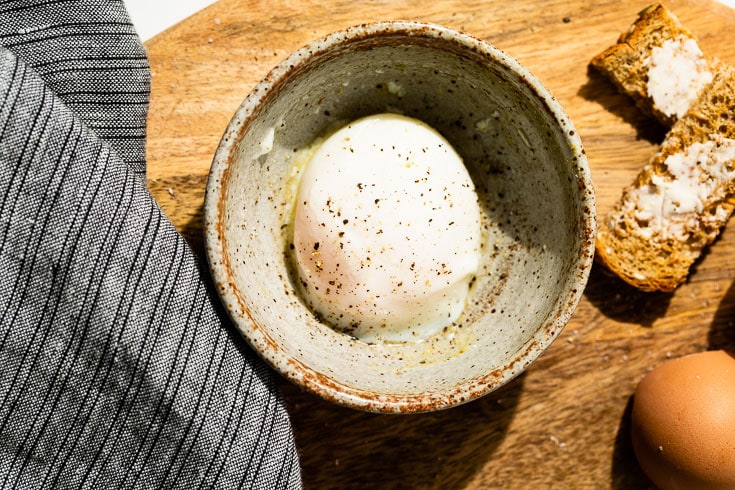
63-Degree Egg vs 75-Degree Egg
There are two popular methods for poaching eggs sous vide. There is a 63° C version that cooks for a long period of time (45 minutes) and a 75° C version that cooks for less than 14 minutes. Just for the simple time difference, the 75° C version is a winner. But it goes beyond just the time. The higher temperature will also firm up the whites a little more to make more of a traditional poached egg texture.
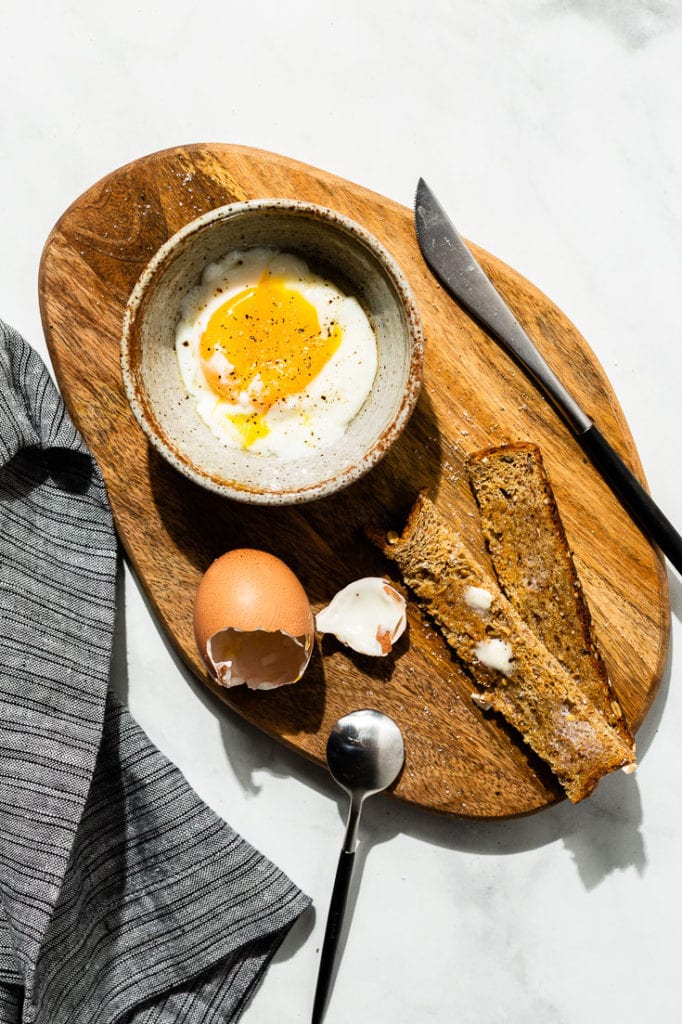
Tips for Sous Vide Poached Eggs
- Only use super-fresh eggs right out of the refrigerator, which will have tighter whites and work better for the poached/soft-cooked result.
- A word of caution: Do a pre-check for cracks. You definitely don’t want an egg floating around in your water bath and getting sucked into the immersion circulator, so only use eggs with no cracks.
- All eggs are different and egg size, age and even what the chicken ate plays a huge role in how they come out when poached. If you don’t get a perfect sous vide egg the first time, try again with different eggs.
- Do a test egg or two ahead of time. It only takes 13 1/2 minutes, so it’s worth a test to make sure you are happy with the texture. If it’s too soft, add a minute or two; if it’s too cooked, take a little time off.
- Experiment and adjust the cooking time to your taste. Keep track of the times by writing notes so you know for next time your exact preference.
- You can make these poached and sous vide scrambled eggs at the same time since they use the same water bath temperature and time.
How to Crack Open a Sous Vide Egg
- The crack method – tap the larger end of the egg on the counter and peel an opening. Hold the egg over a small bowl and use a small spoon to scoop it out.
- The tap method – Use a butter knife and give the large end a quick tap to slice off part of the shell.
- The topper gadget method – The cleanest method for opening up a cooked egg is with the Rosle Egg Topper. It’s the best way when you will be eating the egg right in its shell.
Recipe FAQs
The perfect soft poached sous vide egg temperature is 75° C / 167° F.
13 minutes 30 seconds is the baseline time, but it depends on your specific eggs and preference. Test one egg out and do a little more or less time to make it just right for you.
Yes, you sure can. While sous vide essentially eliminates overcooking for many foods, eggs and fish are a couple of examples of foods that can overcook in a sous vide water bath. It’s important to stick to the suggested cook time and not leave them in longer.
This list could go on forever. To start, you might want to enjoy your perfect poached eggs with some sliced toast. After that, add them to avocado toast, with eggs benedict, on a salad or just about anything else you could imagine.
Tools and Equipment for Sous Vide Eggs
You can check out the equipment used (below) or check out the post all about Essential Sous Vide Accessories.
- Sous Vide Machine
- Sous Vide water bath container or large pot
- Spider Strainer or slotted spoon
- Rosle Egg Topper to cleanly cut the top off the eggs

Sous Vide Eggs
Ingredients
- eggs (large very fresh cold )
- kosher salt & freshly ground pepper for serving
Instructions
- Pre-heat the sous vide water bath to 75° C / 167° F.
- Use a slotted spoon or spider to gently set the eggs at the bottom of the container.
- Cook for 13 minutes 30 seconds then remove and run under cold tap water for about 30 seconds OR into an ice bath for a few seconds until cool enough to be able to handle. Crack and transfer into small bowls or right on top of toast. Season with kosher salt & pepper.
Notes
- Recipe works for as many eggs as you want to cook.
- Pre-check the eggs for cracks.
- Do a test before cooking a large batch, since different size and age eggs cook differently.
- The Rosle Egg Topper works great for taking the top of the cooked eggs to easily remove them with a small spoon from the shell.

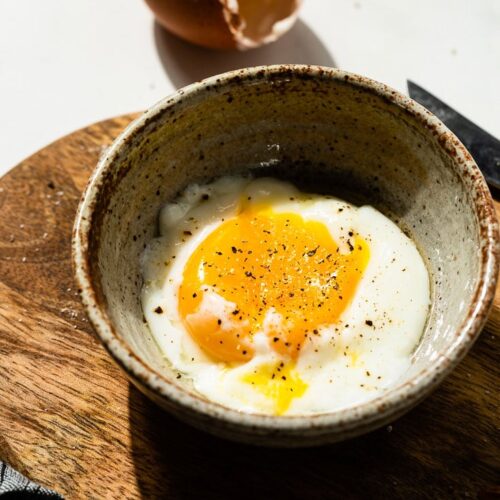

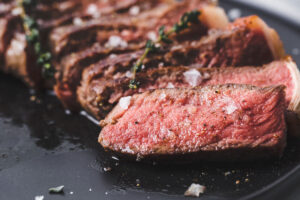



If the white is not done to your liking, a longer cook time will help but also cook the yolk. The answer is a higher temp to cook the whites but leave the yolk runny.
I have an LG Signature stove with a sous vide on the stove top.
I did this exactly but 14 min. In did 12 at a time. The yolk was great, bc i like it runny. But the white was gross, it was partially cooked, partially not. I put them in the microwave after. :/
I’ve read about the high altitude not being a thing, but apparently it is. I had the techs come out bc i thought my stove was broken. But they said it was not and that they need to cook longer due to elevation. I’m in Utah on a mtn. 🙂
Very interesting about the altitude. Did you happen to test making a single egg to see how that came out? I’m not familiar with your stove, but it’s possible that doing 12 eggs dropped the water temp enough where it needed more time to come back up to temp to properly cook the egg whites. I have also found for me that different eggs come out different, so I will usually do a test one first before making a big batch.
Thanks for the info!
Justin, I live in Colorado at 6200 feet, what would you recommend for Cook time compared to your instructions?
Hi Pat! I don’t personally have experience cooking sous vide at elevation, but the elevation should have no effect on the cook time. Elevation changes the boiling point of water, but you aren’t boiling the water for these. 167° F is 167° F no matter where you are. 🙂
I followed the instructions but my egg came out soft boiled in the middle so I’ll just lower the cook time. But I had a time getting the shell off after the quick ice bath. Any tips?
Hi Kym! What I use most for getting the egg out of the shell is a Rösle Egg Topper (affiliate). It takes the top off, then I use a small spoon to scoop it into a bowl. Another way is to use a very shark knife and slice off the top which will do something similar. Or I like to carefully crack it over a bowl, then use a spoon to scoop it out. Hope this helps. 🙂
Not sure how, but I ended up with solid yolks and undercooked whites, whereas I was hoping for running yolks and a white consistency more cohesive than double cream.
Fresh large eggs, 13 minutes at 75’C. Eggs were at room temperature prior to cooking.
Sorry to hear they didn’t come out perfect for you on the first try. I would recommend to not temper the eggs. Try to cook them in the water bath right out of the fridge. Let me know if you have a chance to test again.
Hi. I found the same issue, although some turned out better than others. Try this variation: drop the eggs into a pot of hard-boiling water. Shock them for about 10-15 seconds. Then drop them in the sous vide. I find that shocking the eggs in boiling water
separates the whites from the shells and makes for a more consistent texture in the whites.
Hey Philip! That’s a great tip. I’d definitely give that a try to see how it works. It is another step, so it’s gotta be worth it. 🙂
Came out stupid runny (more like egg soup), which is fine. It’s what I expect from onsen tamago, but didn’t match the pictures at all. I might try it again with 16 minutes cook time. This was with extra large eggs and an InstaPot Sous Vide function.
Hi Jeffrey. Sorry yours didn’t turn out the first time. I’d bet it’s because of the XL eggs. Try testing out more time or with large eggs.
As an update I’m still using 167 C for the cook temperature, but I do L Eggs for 19 minutes and XL Eggs for 20 minutes. Not as runny, and you need to scrap out the inside of the egg with a butter knife, but it still spreads on toast excellently.
Perfect. I cracked the shell and out came a beautifully cooked egg. I have a large cooking vessel, so I did not have to worry about the temperature falling. The question is, if they stay longer in the water will they get cooked more. I know the obvious answer is yes, but with the sous vide, it keeps food at that temperature so it won’t overcook, so will that work with eggs? No matter what making a large batch of Eggs Benedict on the weekend, and just saved time of poaching each egg by itself. Thanks
Hey Brad! A large batch of eggs benedict sounds pretty amazing. 😛
I hope it turned out wonderful. So eggs (and most fish) are more delicate and there is less variability so they can overcook if left in too long at the cooking temp. You could hold pre-cook and put them in an ice bath, then re-heat and hold them at a lower temperature so they don’t cook. I haven’t done a while lot of experimenting with this though (but I should). Cheers!
Thanks for this! Delicious!
So glad to hear it, Lisa! Definitely one of my favorites!
Hi Justin
Is it possible to cook these eggs ahead of time ? How would i reheat later ,and for how long?
Thanks
Hi Steve,
It is possible to cook these ahead of time, but since this recipe/method only cooks for less than 14 minutes, it’s really best to just make them fresh each time as it will take almost that long to safely re-heat them.
Cheers,
Justin
Are you cooking them exactly for 13.5 mins after you put them in the water using a separate timer? Because once you put eggs in the water, the temp drops slightly and the timer doesn’t start counting down until the water is back up to temp….meaning the eggs can end up being in there a couple extra mins. hope that made sense.
Hi Lilly,
Yep, that makes sense. I use a separate timer and not the one associated with the immersion circulator (sous vide machine). I start my timer as soon as they go into the water because that’s when they start cooking. If you are using a small container with not much water or are cooking a lot of eggs at once, the temperature of the water will drop more drastically.
If the temp drops a lot, then try using more water.
Cheers,
Justin
Run hot tap water over the eggs prior to cooking to get the chill off of them and reduce the time with the eggs in the Sous vide coming back up to temp. Do this while you’re setting up the Sous vide and they’ll be ready by the time you’re set up.
That is true but keep in mind it takes about 30 minutes to heat the water to 167* depending on the temp. of the water out of your faucet.
True, there is the sous vide heat up time but 30 minutes is quite a long time. Which machine are you using?
Turned out perfect with large eggs straight out of fridge
Great to hear. They are so good on just about anything!
Annova original.
Works OK, but not great. Using an Anova at167F and 14 minutes the yolks are over cooked and not very runny.
Sorry to hear they didn’t come out perfect for you, Blanca. What size eggs were you using and were they right out of the refrigerator? The recipe calls for a little less time than you said and be sure to run them under cold water after the sous vide.